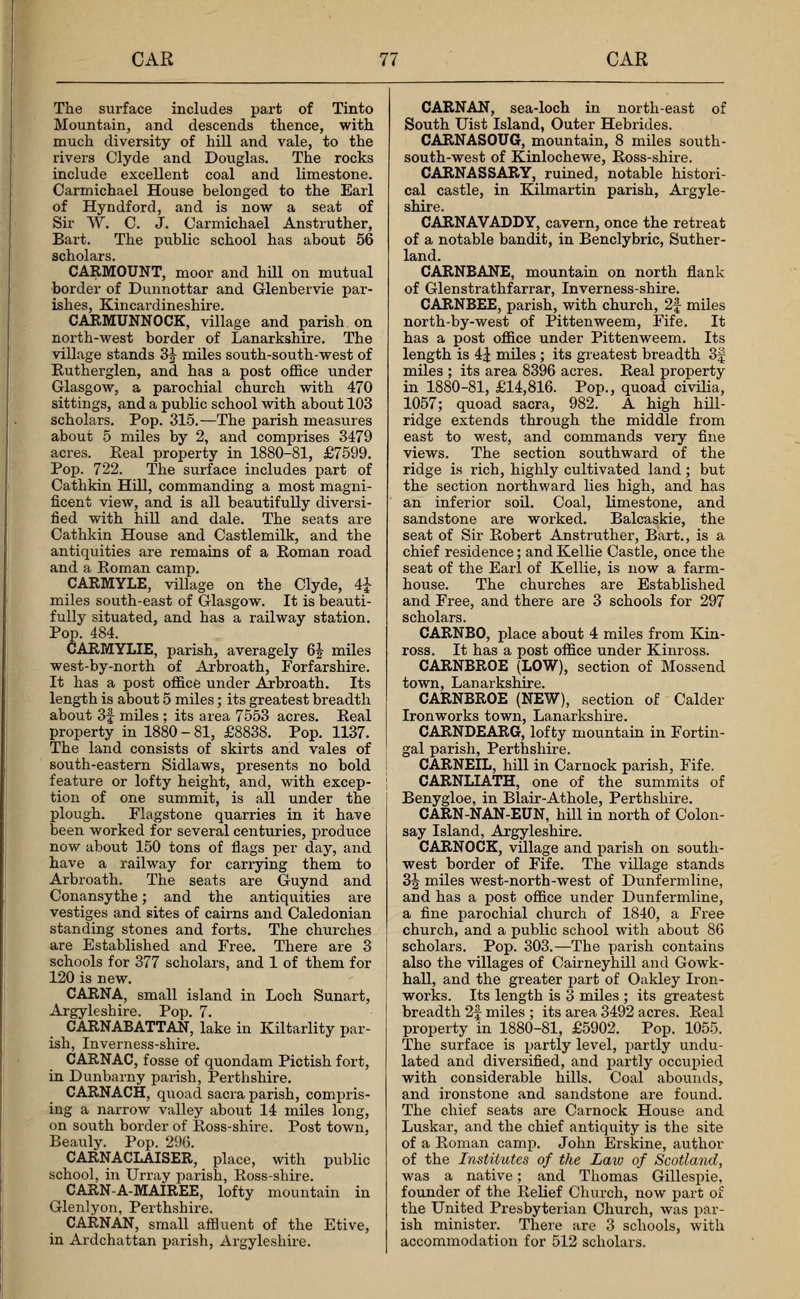CARMOUNT, moor and hill on mutual border of Dunnottar and Glenbervie parishes, Kincardineshire.
CARMUNNOCK, village and parish on north-west border of Lanarkshire. The village stands 3 miles south-south-west of Rutherglen, and has a post office under Glasgow, a parochial church with 470 sittings, and a public school with about 103 scholars. Pop. 315. The parish measures about 5 miles by 2, and comprises 3479 acres. Keal property in 1880-81, 7599. Pop. 722. The surface includes part of Cathkin Hill, commanding a most magnificent view, and is all beautifully diversified with hill and dale. The seats are Cathkin House and Castlemilk, and the antiquities are remains of a Roman road and a Roman camp.
CARMYLE, village on the Clyde, 4J miles south-east of Glasgow. It is beautifully situated, and has a railway station. Pop. 484.
CARMYLIE, parish, averagely 6 miles west-by-north of Arbroath, Forfarshire. It has a post office under Arbroath. Its length is about 5 miles ; its greatest breadth about 3| miles ; its area 7553 acres. Real property in 1880-81, 8838. Pop. 1137. The land consists of skirts and vales of south-eastern Sidlaws, presents no bold feature or lofty height, and, with exception of one summit, is all under the plough. Flagstone quarries in it have been worked for several centuries, produce now about 150 tons of flags per day, and have a railway for carrying them to Arbroath. The seats are Guynd and Conansythe ; and the antiquities are vestiges and sites of cairns and Caledonian standing stones and forts. The churches are Established and Free. There are 3 schools for 377 scholars, and 1 of them for 120 is new.
CARNA, small island in Loch Sunart, Argyleshire. Pop. 7.
CARNABATTAN, lake in Kiltarlity parish, Inverness-shire.
CARNAC, fosse of quondam Pictish fort, in Dunbarny parish, Perthshire.
CARNACH, quoad sacra parish, comprising a narrow valley about 14 miles long, on south border of Ross-shire. Post town, Beauly. Pop. 296.
CARNACLAISER, place, with public school, in Urray parish, Ross-shire.
CARN-A-MAIREE, lofty mountain in Glenlyon, Perthshire.
CARNAN, small affluent of the Etive, in Ardchattan parish, Argyleshire.
CARNAN, sea-loch in north-east of South Uist Island, Outer Hebrides.
CARNASOUG, mountain, 8 miles south-south-west of Kinlochewe, Ross-shire.
CARNASSARY, ruined, notable historical castle, in Kilmartin parish, Argyleshire.
CARNAVADDY, cavern, once the retreat of a notable bandit, in Benclybric, Sutherland.
CARNBANE, mountain on north flank of Glenstrathfarrar, Inverness-shire.
CARNBEE, parish, with church, 2| miles north-by-west of Pittenweem, Fife. It has a post office under Pittenweem. Its length is 4J miles ; its greatest breadth 3| miles ; its area 8396 acres. Real property in 1880-81, 14,816. Pop., quoad civilia, 1057; quoad sacra, 982. A high hill-ridge extends through the middle from east to west, and commands very fine views. The section southward of the ridge is rich, highly cultivated land ; but the section northward lies high, and has an inferior soil. Coal, limestone, and sandstone are worked. Balcaskie, the seat of Sir Robert Anstruther, Bart., is a chief residence ; and Kellie Castle, once the seat of the Earl of Kellie, is now a farm-house. The churches are Established and Free, and there are 3 schools for 297 scholars.
CARNBO, place about 4 miles from Kinross. It has a post office under Kinross.
CARNBROE (LOW), section of Mossend town, Lanarkshire.
CARNBROE (NEW), section of Calder Ironworks town, Lanarkshire.
CARNDEARG, lofty mountain in Fortingal parish, Perthshire.
CARNEIL, hill in Carnock parish, Fife.
CARNLIATH, one of the summits of Benygloe, in Blair-Athole, Perthshire.
CARN-NAN-EUN, hill in north of Colon-say Island, Argyleshire.
CARNOCK, village and parish on south-west border of Fife. The village stands 3J miles west-north-west of Dunfermline, and has a post office under Dunfermline, a fine parochial church of 1840, a Free church, and a public school with about 86 scholars. Pop. 303. The parish contains also the villages of Cairneyhill and Gowkhall, and the greater part of Oakley Iron-works. Its length is 3 miles ; its greatest breadth 2| miles ; its area 3492 acres. Real property in 1880-81, 5902. Pop. 1055. The surface is partly level, partly undulated and diversified, and partly occupied with considerable hills. Coal abounds, and ironstone and sandstone are found. The chief seats are Carnock House and Luskar, and the chief antiquity is the site of a Roman camp. John Erskine, author of the Institutes of the Law of Scotland, was a native ; and Thomas Gillespie. founder of the Relief Church, now part of the United Presbyterian Church, was parish minister. There are 3 schools, with accommodation for 512 scholars.

